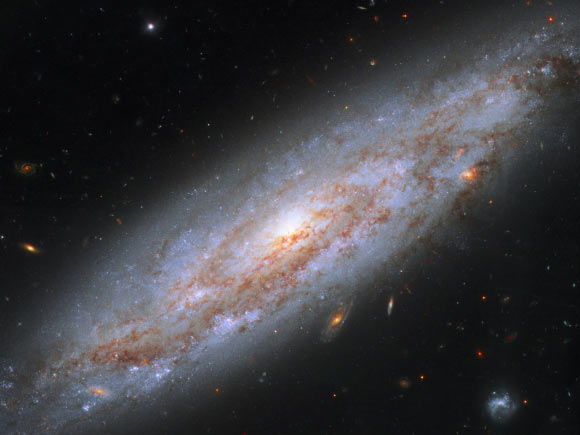How fast the universe is expanding?

Patterns in the distribution of galaxies can help us measure the expansion of the universe.
The universe has been expanding ever since the Big Bang. But there is a problem.
We don’t know exactly how fast it is expanding because there are tiny discrepancies in one of the most fundamental and controversial numbers in physics.
The Hubble constant (Ho) tells us how fast an object is currently moving away from us, where the velocity of the object is proportional to its distance from us.
“The more distant the galaxy, the faster it’s moving,” explained astrophysicist Tamara Davis of the University of Queensland.
Knowing just how fast this expansion is happening can give us clues about how old the universe is and what it is made of.
The currently accepted value of the Hubble constant is 70 kilometres per second per megaparsec, plus or minus 5km. A megaparsec is approximately 3.26 million light-years.
That gives us an age of 13.7 billion years for the universe.
But lately, in what some astrophysicists have dubbed a “crisis in cosmology”, different techniques for measuring the Hubble constant have yielded slightly different figures.
“Does this small discrepancy we’re looking at now indicate we’ve discovered something profound and new about the universe that we haven’t explained yet?” Professor Davis said.
“Or does it mean we’ve just stuffed up our measurements, and we’re not measuring it as accurately as we think we are?”
In the latest attempt to tackle the problem, researchers have harnessed the magnifying power of galaxies to warp spacetime and bend light.
A constant history of controversy
The discovery that the universe was expanding — made in the 1920s by both Georges Lemaitre and Edwin Hubble independently — revolutionised how we viewed cosmology.
“It told us that the universe had a beginning, amongst other things, which was contrary to what scientific views had been at the time,” Professor Davis said.
Almost as soon as Lemaitre and Hubble came up with what is now known as the Hubble-Lemaitre Law, there has been controversy around the value of Ho.
They initially proposed the figure of 500 km per second per megaparsec.
But there was a problem; if the universe was expanding that fast it only took two billion years to get to the size it is today.
“That’s why a lot of people didn’t believe the result initially, and didn’t believe the universe actually had a beginning and a Big Bang,” Professor Davis said.
We also knew that the oldest stars we could see in the sky were around 13 to 14 billion years old.
What came before the Big Bang?
Lemaitre and Hubble based their measurements on the brightness of blinking stars known as Cephid variables.
“And with the telescopes that they had at the time, they just didn’t have the technology or the accuracy to do that very well,” Professor Davis said.
As telescope technology improved astrophysicists wavered between figures of 50km per second per megaparsec to 100km per second per megaparsec.
In 1998 two teams, including one headed by Brian Schmidt at the Australian National University, discovered the rate of expansion was accelerating. They proposed the acceleration was caused by dark energy, which makes up 70 per cent of the universe.
Soon after, astrophysicists reached a consensus on the Hubble constant.
“It got to the point where everyone was like ‘Ah, phew we’re done. We know the Hubble constant now. It’s 70’,” Professor Davis said.
The expansion of the universe was originally measured using blinking stars, called Cephid stars.
But two decades later, the debate has flared up again, as more techniques give slightly different answers.
“It’s like that old quote: ‘A person with one watch knows the time, a person with two watches is never sure’,” Professor Davis said.
Tiny discrepancies have cropped up as the methods used to measure the Hubble constant have become so precise.
“We’re not questioning the expansion, we’re not even questioning in great detail how old the universe is, we’re just questioning the very precise nature of a 1 per cent difference.”
How do we measure the constant?
There are two components to how we calculate the Hubble constant: velocity and distance.
Velocity is measured by the wavelength of electromagnetic radiation from an object.
If something is moving away from us, the wavelength of signals will move towards the red end of the electromagnetic spectrum (known as a red shift). If it is moving towards us, the signal will be more towards the blue end (known as a blue shift).
Distance is measured using either standard candles or standard rulers.
A standard candle is something that has a known brightness such as a Cephid star or, even more reliable, a supernova.
“By measuring how bright they appear, we can measure how far they are away,” Professor Davis said.
Supernovae such as Cassiopeia A are used as standard candles.
Standard rulers, on the other hand, use objects of a known size to calculate distance.
“We use big structures in the universe as a standard ruler,” Professor Davis said.
These include fluctuations in the afterglow of the Big Bang, known as the cosmic microwave background radiation, and patterns of galaxy distribution.
“We see the original patterns in the cosmic microwave background, which is essentially the afterglow from the Big Bang.”
Then billions of years later the pattern still persists in the pattern of galaxies we see because the galaxies formed from those original fluctuations.”
But it’s in these two methods of measuring distances where the problem for the Hubble constant arises.
“At moment the standard rulers are giving us numbers that are sort of 67 or 68km per second per megaparsec plus or minus about 0.5, whereas the standard candles are giving us numbers more like 73.5 plus or minus 1.”
What does warping spacetime tell us?
In the latest attempt to pin down the Hubble constant, researchers have used a technique called gravitational lensing to create a standard ruler.
This technique allows us to see more distant objects — in this case a quasar — using the gravitational power of closer galaxies.
Gravitational lensing bends spacetime and deflects light from distant objects.
“Gravity bends the path of light so we can see a distant object by light that’s travelled multiple different routes to reach us,” Professor Davis said.
The width between the different routes tells you how strong the gravity of the closer object is.
Not only does the light take different routes, but light travelling along those routes reaches us at different times so we detect one image of the background object before the other.
The measurement of this difference as well as the velocity of the rotating stars in the foreground galaxy gives us the mass of the foreground galaxy.
“We can compare that to how much bending we see and that gives us the standard ruler.”
Using this method, the researchers arrived at a figure of 82 km per second per megaparsecs, give or take 8 km, they reported in the journal Science.
That is higher than the current value for the Hubble constant, Professor Davis wrote in a separate commentary.
If correct, the number would make the universe younger than we think, but there is a big margin of error — the lower range (74km per second per megaparsec) is around the same figure given by standard candles — so the debate is far from over.
Other new methods, such as using gravitational waves from colliding stars to calculate Ho, could also help to solve the problem.
Why do we want to pin down this number?
Working out why there’s a difference in the distance measurement given by standard candles and standard rulers could help physicists solve some of the curliest questions in the cosmos.
If the different techniques really are measuring different expansion rates, it could mean something profound about the nature of gravity or the nature of our universe that has not been predicted by physics models.
“There’s still things we don’t understand about fundamental physics, and it’s getting harder and harder to find places where our predictions of fundamental physics don’t work,” Professor Davis said.
“But we still don’t know how the universe began.
“We still don’t know how to merge that beautiful theory of particles with our theory of gravity, and those two theories are actually contradictory in some ways.”
So when a number comes up that is different to what is predicted — albeit by a tiny margin — it could be significant.
“And debating whether it’s an observational error or it’s something that is more profound is exciting.”



